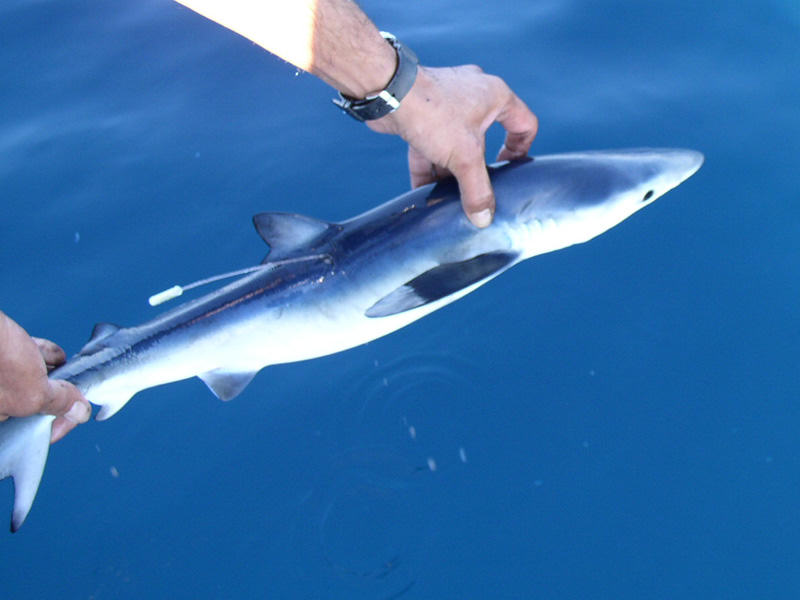Blue shark (Prionace glauca)
Distribution data supplied by the Ocean Biodiversity Information System (OBIS). To interrogate UK data visit the NBN Atlas.Map Help
| Researched by | Nuno Queiroz | Refereed by | Admin |
| Authority | (Linnaeus, 1758) | ||
| Other common names | - | Synonyms | - |
Summary
Description
Recorded distribution in Britain and Ireland
Blue sharks undertake north-south migrations in the north-east Atlantic and seasonally visit western British and Irish waters in the summer.Global distribution
-Habitat
The blue shark is probably the widest ranging shark found in the main oceans and seas of the world, from the surface to at least 400 m depth. Blue sharks are a migratory species.Depth range
-Identifying features
- Slender body.
- Long and narrow snout.
- Large eyes.
- Pectoral fins very narrow and somewhat falcate.
- Colour intense deep blue above, white below.
Additional information
The blue shark is often seen cruising slowly at the surface, with its large pectoral fins outspread, and its first dorsal fin and terminal caudal lobe out of the water. It is a viviparous species and the number of young varies from 4 to 135 per litter, with a size at birth around 40 cm. The gestation period is from 9 to 12 months, and possible maximum longevity is around 20 years. Males mature around 180 to 200 cm and females around 220 cm in length.The blue shark feeds on relatively small prey, especially squid and bony fishes, though other invertebrates, small sharks, and mammalian carrion is readily taken and seabirds occasionally are caught at the surface of the water. Squid are a very important prey of the blue shark and some species form huge breeding aggregations, which are attended by blue sharks. Much of the prey of the blue shark is pelagic, though bottom fishes and invertebrates figure in its diet also.
This common oceanic shark is usually caught with pelagic longlines but also pelagic trawls, and even bottom trawls near coasts.Listed by
Bibliography
Costello, M.J., Bouchet, P., Boxshall, G., Emblow, C. & Vanden Berghe, E., 2004. European Register of Marine Species [On-line]. http://www.marbef.org/data/erms.php,
FishBase, 2000. FishBase. A global information system on fishes. [On-line] http://www.fishbase.org, 2001-05-03
Datasets
Fenwick, 2018. Aphotomarine. Occurrence dataset http://www.aphotomarine.com/index.html Accessed via NBNAtlas.org on 2018-10-01
Isle of Wight Local Records Centre, 2017. IOW Natural History & Archaeological Society Marine Records. Occurrence dataset: https://doi.org/10.15468/7axhcw accessed via GBIF.org on 2018-09-27.
NBN (National Biodiversity Network) Atlas. Available from: https://www.nbnatlas.org.
OBIS (Ocean Biodiversity Information System), 2025. Global map of species distribution using gridded data. Available from: Ocean Biogeographic Information System. www.iobis.org. Accessed: 2025-07-26
Scottish Shark Tagging Programme, 2018. Capture Mark Recapture Data for Scottish Elasmobranchs: 2009-2018. Occurrence dataset: https://doi.org/10.15468/znol4z accessed via GBIF.org on 2018-10-02.
West Wales Biodiversity Information Centre, 2018. Seatrust Cetacean Records West Wales. Occurrence dataset: https://doi.org/10.15468/ecsmqh accessed via GBIF.org on 2018-10-02.
Citation
This review can be cited as:
Last Updated: 02/01/2007



